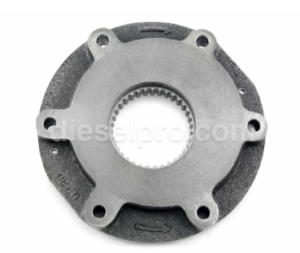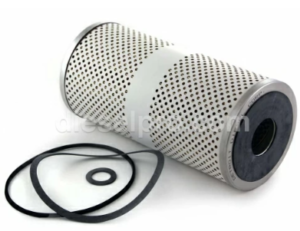
Proper lubrication and cooling are essential for maintaining the efficiency, longevity, and reliability of Detroit Diesel 53 Series engines. These systems work in tandem to prevent overheating, reduce wear, and ensure smooth operation under various conditions.
Lubrication System For Detroit Diesel 53 Series Engines (3-53, 4-53, 6V53, 8V53)

Oil Pump Operation and Pressure Testing for Consistent Lubrication
The oil pump in Detroit Diesel 53 Series engines is a positive displacement gear pump, designed to deliver consistent oil pressure throughout the engine. Its primary role is to ensure that all moving components receive adequate lubrication, reducing friction and preventing overheating.
Oil Pump Operation
- Design and Placement:
- The oil pump is mounted in the engine’s lower front cover (for inline and 6V engines) or integrated with the outboard bearing support assembly (for 8V engines).
- It draws oil from the sump through the inlet screen and delivers it under pressure to the main oil gallery.
- Lubrication Path:
- From the pump, oil flows to the filter and cooler before reaching critical components such as the crankshaft, camshaft, connecting rods, and valve train.
- Excess oil from the rocker arms lubricates the valve stems and drains back to the oil pan.
Pressure Testing Procedure
Regular oil pressure testing ensures the pump delivers oil at the correct pressure, preventing inadequate lubrication that could lead to engine damage.
- Preparation:
- Warm up the engine to operating temperature (160-200°F).
- Connect an oil pressure gauge to the designated test port on the main oil gallery.
- Testing Steps:
- Start the engine and note the oil pressure at idle and at rated speed.
- Pressure should fall within specified limits:
- Idle: 10-15 psi.
- Rated Speed: 50-70 psi.
- Troubleshooting Low Pressure:
- Inspect the oil pump for wear or damage to the gears.
- Check for clogged oil passages, a dirty filter, or insufficient oil levels.
- Pressure Relief Valve:
- Test the pressure relief valve for proper operation. It maintains oil pressure within safe limits, typically around 65-70 psi, by diverting excess oil back to the sump.
- Test the pressure relief valve for proper operation. It maintains oil pressure within safe limits, typically around 65-70 psi, by diverting excess oil back to the sump.
Filter Replacement Intervals and Oil Specifications

Filter Replacement Guidelines
Oil filters capture contaminants, preventing them from circulating through the engine and causing wear. Regular filter replacement is crucial.
- Intervals:
- Replace oil filters at the manufacturer’s recommended intervals, typically every 100 to 250 hours, depending on operating conditions.
- Replace filters more frequently in dusty or harsh environments.
- Procedure:
- Drain the oil before removing the filter.
- Inspect the old filter for metal shavings or debris, which may indicate internal wear.
- Install a new filter, ensuring it is properly seated and sealed.
Oil Specifications
Using the correct oil ensures optimal lubrication and engine protection.
- Type:
- Use high-quality, detergent-type diesel engine oil meeting API classification CF-2 or higher.
- Multi-viscosity oils (e.g., SAE 15W-40) are recommended for varying ambient temperatures.
- Capacity:
- Oil capacity varies by engine model:
- 3-53: ~2.5 gallons.
- 4-53: ~3.5 gallons.
- 6V53: ~6 gallons.
- 8V53: ~8 gallons.
- Oil capacity varies by engine model:
- Monitoring:
- Regularly check the oil level and quality.
- Maintain oil levels between the “add” and “full” marks on the dipstick.
Lubrication system & Related Components for Detroit Diesel 353 Non–Turbo Marine & Industrial Engines
Lubrication system & Related Components for Detroit Diesel 353 Turbo Marine & industrial Engines
Lubrication system & Related Components for Detroit Diesel 453 Non – Turbo Marine & industrial Engines
Lubrication system & Related Components for Detroit Diesel 453 Turbo Marine & industrial Engines
Lubrication system & Related Components for Detroit Diesel 6V53 Non – Turbo Marine & industrial Engines
Lubrication system & Related Components for Detroit Diesel 6V53 Turbo Marine & industrial Engines
Lubrication system & Related Components for Detroit Diesel 8V53 Non – Turbo Marine & industrial Engines
Lubrication system & Related Components for Detroit Diesel 8V53 Turbo Marine & industrial Engines
Cooling System For Detroit Diesel 53 Series Engines (3-53, 4-53, 6V53, 8V53)
![Water Pump for Detroit Diesel Engine 53 series [left hand rotation]](http://dieselpro.com/blog/content/uploads/2024/09/Screenshot-2024-11-06-at-5.18.07 PM-300x229.png)
Radiator and Thermostat Guidelines to Maintain Optimal Engine Temperature
The cooling system in Detroit Diesel 53 Series engines ensures that engine components operate within the recommended temperature range, preventing overheating and thermal stress.
Radiator Maintenance
- Inspection:
- Check the radiator for leaks, blockages, or damaged fins.
- Use a pressure tester to verify the radiator cap holds the recommended pressure (typically 7-15 psi).
- Cleaning:
- Periodically clean the radiator exterior to remove dirt and debris. Use compressed air or a low-pressure water stream.
- Periodically clean the radiator exterior to remove dirt and debris. Use compressed air or a low-pressure water stream.
- Coolant Levels:
- Maintain coolant levels at the recommended capacity to ensure efficient heat dissipation.
- Maintain coolant levels at the recommended capacity to ensure efficient heat dissipation.
Thermostat Operation and Replacement
- Role:
- The thermostat regulates coolant flow to maintain engine temperatures between 160°F and 180°F.
- The thermostat regulates coolant flow to maintain engine temperatures between 160°F and 180°F.
- Testing:
- Remove the thermostat and place it in water heated to its rated opening temperature (e.g., 180°F).
- Use a thermometer to verify that it opens fully at the specified temperature.
- Replacement:
- Replace thermostats that do not open at the correct temperature or exhibit physical damage.
- Replace thermostats that do not open at the correct temperature or exhibit physical damage.
Troubleshooting Overheating and Coolant Circulation Issues For Detroit Diesel 53 Series Engines (3-53, 4-53, 6V53, 8V53)

Overheating Causes and Solutions
- Low Coolant Levels:
- Cause: Leaks in the system or improper filling.
- Solution: Locate and repair leaks, refill the system with a 50/50 mix of coolant and distilled water.
- Blocked Radiator or Hoses:
- Cause: Debris or scale buildup restricting flow.
- Solution: Flush the cooling system and inspect for obstructions.
- Faulty Water Pump:
- Cause: Worn impeller or loose drive belt.
- Solution: Replace the water pump or tighten the belt to the manufacturer’s specifications.
- Air Trapped in the System:
- Cause: Improper filling of the coolant.
- Solution: Bleed air from the system using the designated bleeder valve.
Coolant Circulation Testing
-
Flow Check:
- Start the engine and observe coolant flow in the radiator with the cap removed.
- If flow is insufficient, check the water pump and thermostat.
-
Pressure Test:
- Use a cooling system pressure tester to identify leaks or weaknesses in the system.
- Use a cooling system pressure tester to identify leaks or weaknesses in the system.
-
Flush and Refill:
- Periodically flush the system to remove contaminants.
- Refill with a 50/50 coolant mix, ensuring the use of ethylene glycol-based antifreeze.
Preventive Maintenance Tips for Cooling System

- Inspect Components Regularly:
- Check hoses, clamps, and fittings for leaks or wear.
- Check hoses, clamps, and fittings for leaks or wear.
- Use Correct Coolant Mix:
- Always use a 50/50 mix of coolant and distilled water to prevent corrosion and freezing.
- Always use a 50/50 mix of coolant and distilled water to prevent corrosion and freezing.
- Monitor Operating Temperatures:
- Use the engine temperature gauge to ensure the engine operates within the recommended range.
- Use the engine temperature gauge to ensure the engine operates within the recommended range.
- Flush System Annually:
- Remove old coolant and scale buildup to maintain efficient heat transfer.
Cooling system & Related Components for Detroit Diesel 353 Non–Turbo Marine & Industrial Engines
Cooling system & Related Components for Detroit Diesel 353 Turbo Marine & Industrial Engines
Cooling system & Related Components for Detroit Diesel 453 Non – Turbo Marine & Industrial Engines
Cooling system & Related Components for Detroit Diesel 453 Turbo Marine & Industrial Engines
Cooling system & Related Components for Detroit Diesel 6V53 Non – Turbo Marine & Industrial Engines
Cooling system & Related Components for Detroit Diesel 6V53 Turbo Marine & Industrial Engines
Cooling system & Related Components for Detroit Diesel 8V53 Non – Turbo Marine & Industrial Engines
Cooling system & Related Components for Detroit Diesel 8V53 Turbo Marine & Industrial Engines
- Remove old coolant and scale buildup to maintain efficient heat transfer.



 Free US Calls: 1-888-433-4735
Free US Calls: 1-888-433-4735 International: 305-545-5588
International: 305-545-5588